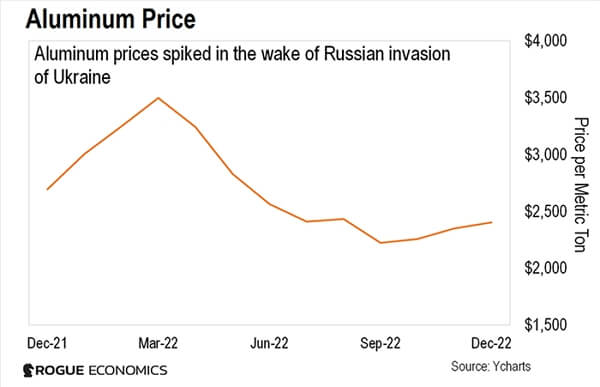Aluminum Vital Metal for 2023
Authored by: Nomi Prins
Aluminum prices are about to explode in future supply shortages. This is a significant development, yet only a few people are talking about it. Earlier this month, Goldman Sachs lifted its price forecasts for aluminum to $3,125 per ton during 2023.
That's much higher than its previous forecast of $2,563 per ton and its current price of $2,595 per ton. Their reasoning? The reopening of China and more robust demand for metal in Europe.
Shortages have become commonplace over the past one to two years. You've probably read a lot about global supply troubles in everything from drugs to computer chips.
But what you need to hear about is that the world is also running critically low on the basic materials that make almost everything we use - Aluminum fits the bill.
Global aluminum supplies have been evaporating. Stockpiles around the globe have been taking hits from all directions since the pandemic. And aluminum inventories are now at their lowest levels since 2002.
According to Goldman, global inventories, at around 1.4 million tons, are down by almost 900,000 tons from a year ago. That's something if you consider that the metal already faced a steep shortfall in stockpiles in 2021-2022.
The so-called " aluminum can shortage" happened because more people were drinking at home during and after the Covid lockdowns rather than going out. That led to a shortage of aluminum to make cans. However, it it's different this time around though.
Aluminum Driven by Energy Price Spikes
Goldman argues that higher aluminum demand from Europe and China could trigger scarcity concerns in the aluminum market. But that's just one side of the coin.
You see, making aluminum requires a lot of energy. So much, so that aluminum smelters are usually built in places with access to cheap power. But the Russian-Ukraine War threw a massive monkey wrench into all that. The conflict led to an enormous rise in energy costs, and the resulting supply crunch spiked aluminum prices at the beginning of 2022.

As you can see in the chart above, the price of aluminum hit peaks in February 2022, following Russia's invasion of Ukraine. It has since fallen, though. And with natural gas going through the roof, many aluminum smelters face huge losses.
We've seen many headlines about European power shortages shutting down aluminum refineries. Take Norsk Hydro, for example. It's one of the biggest aluminum producers in the world, and it shut down primary production at one of its plants last fall. Europe's top aluminum plant, Aluminium Dunkerque Industries France, cut output by 22%.
As a result, Western European aluminum output stood at an annualized 2.73 million metric tons in December. That was down a staggering 17% from 3.27 million metric tons in December 2021. And it's the lowest production rate this century.
Meanwhile, in the U.S., we've gone from having 23 operational aluminum smelters in 1993 to just six today. And most of these need more maximum capacity. These facilities were running at about 50% capacity as recently as 2021.
All this will probably get worse as the energy crisis hits harder amid the ongoing war in Ukraine. Now, it's true that aluminum prices have gone up lately. But more is needed to cover higher energy costs at smelters. Could refineries in places like China make up for the missing production? They might, to a certain degree…
But China, too, has been struggling with power problems, most recently in the hydro-rich provinces of Yunnan and Sichuan. There's also one factor that plays something of a wild card in this story: the West's potential ban on Russia's aluminum.
Now, Russian aluminum isn't sanctioned… yet. In November 2022, the London Metal Exchange (LME) decided against banning supplies of Russian metal from the bourse. But with no sign of Russia calling off its war in Ukraine, that " status quo" may not last.
The LME is the world center for the trading of industrial metals. It'sIt's where the majority of all non-ferrous metal business happens. Put another way, the LME taking such a step would affect all participants in the aluminum trade worldwide. And other marketplaces would likely follow suit.
Russia is responsible for 6% of global aluminum producers. Removing that supply would push aluminum prices way past what Goldman expects. All of the above tells us that aluminum prices are upward. It's that, or we'll just run out of the metal as more refineries close.
Now, you might be wondering… so what? This is a legitimate question, given that most people associate aluminum with soda cans. You might be holding one in your hand right now. But the importance of aluminum in our daily life is far greater.
Only 25% of the aluminum produced worldwide is used for consumer goods. The remainder goes to some of the world's most important industries, like construction, the electric grid, and information technology. With how strong aluminum is, higher prices are much more likely.
The iPath Series B Bloomberg Aluminum Subindex Total Return ETN (JJU) is a great way to position yourself for rising aluminum prices. It tracks an index of aluminum futures that rolls into new contracts every other month. And it offers convenient exposure to aluminum prices.
This article was printed from TradingSig.com